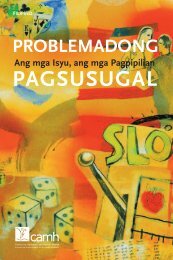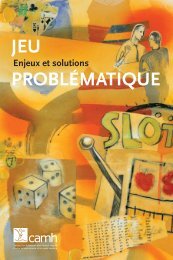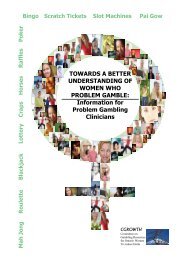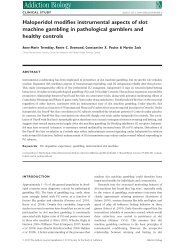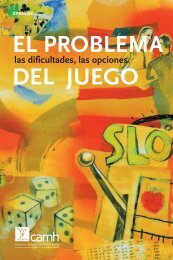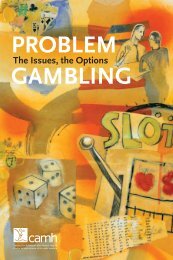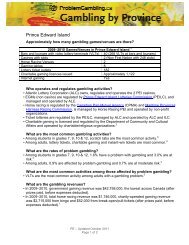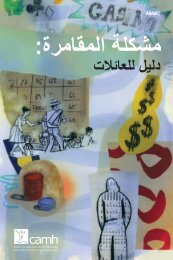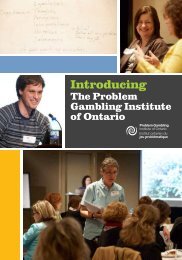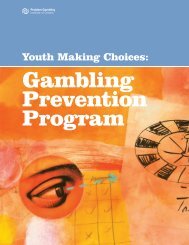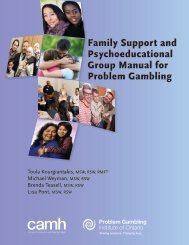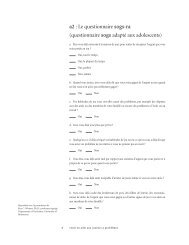Probability, Random Events, and the Mathematics of Gambling
Probability, Random Events, and the Mathematics of Gambling
Probability, Random Events, and the Mathematics of Gambling
Create successful ePaper yourself
Turn your PDF publications into a flip-book with our unique Google optimized e-Paper software.
<strong>R<strong>and</strong>om</strong> <strong>Events</strong><br />
Games <strong>of</strong> chance are made up <strong>of</strong> a series <strong>of</strong> events that are not predictable. If we toss an<br />
unbiased coin, <strong>the</strong> best we can say is that it will l<strong>and</strong> ei<strong>the</strong>r tails-side-up or heads-side-up <strong>and</strong><br />
that <strong>the</strong> two outcomes have <strong>the</strong> same chance <strong>of</strong> occurring. Many <strong>of</strong> <strong>the</strong> beliefs <strong>and</strong> “systems”<br />
people who gamble develop are based on misconceptions about <strong>the</strong> nature <strong>of</strong> r<strong>and</strong>om events.<br />
So it is worthwhile to examine in more detail <strong>the</strong> essence <strong>of</strong> what it means to say that<br />
something is r<strong>and</strong>om.<br />
<strong>R<strong>and</strong>om</strong>ness is difficult to define. <strong>R<strong>and</strong>om</strong> events are unpredictable, erratic, unplanned <strong>and</strong><br />
independent <strong>of</strong> each o<strong>the</strong>r. However, r<strong>and</strong>om events sometimes appear to form a pattern or<br />
serve a purpose. For example, <strong>the</strong>re are areas in <strong>the</strong> night sky, such as Orion’s “belt,” where<br />
stars appear to form a straight line. Given enough opportunity, any pattern could form by<br />
chance alone. An infinite number <strong>of</strong> monkeys on typewriters could eventually type out <strong>the</strong><br />
complete works <strong>of</strong> Shakespeare.<br />
Although r<strong>and</strong>om events appear to happen without a rule or cause, <strong>the</strong>y are in fact <strong>the</strong> result<br />
<strong>of</strong> material cause (e.g., gravity <strong>and</strong> friction), but an exact list <strong>of</strong> forces acting on a r<strong>and</strong>om<br />
number generator (e.g., dice) may be unknown or impossible to specify precisely.<br />
Sometimes clients believe that <strong>the</strong>re is no such thing as r<strong>and</strong>omness <strong>and</strong> that it is <strong>the</strong>refore<br />
possible to predict <strong>the</strong> outcome <strong>of</strong> games. O<strong>the</strong>r people believe that r<strong>and</strong>om events have no<br />
cause, <strong>the</strong>y just happen. This can make r<strong>and</strong>om events seem ra<strong>the</strong>r mysterious. Interestingly<br />
many religions used r<strong>and</strong>om events as part <strong>of</strong> <strong>the</strong>ir religious ritual to divine <strong>the</strong> will <strong>of</strong> <strong>the</strong><br />
gods (Gabriel, 2003). There is nothing mysterious about r<strong>and</strong>om events. All physical events<br />
are determined or caused by something. Mechanical r<strong>and</strong>omizers such as bingo balls, roulette<br />
wheels <strong>and</strong> dice use <strong>the</strong> laws <strong>of</strong> physics to maximize uncertainty. The basis <strong>of</strong> all r<strong>and</strong>om-like<br />
events is a combination <strong>of</strong> (1) initial uncertainty <strong>and</strong> (2) complex or non-linear relationships.<br />
Uncertainty simply means that we do not know <strong>the</strong> exact values <strong>of</strong> all <strong>the</strong> variables with<br />
absolute precision. Uncertainty is an inherent part <strong>of</strong> measurement; nothing is ever 100%<br />
certain. A car driving at 70 kilometres per hour in cruise control will vary in speed by 1 or 2<br />
kilometres per hour (more on a hilly highway). Thus <strong>the</strong>re is some uncertainty as to <strong>the</strong> exact<br />
speed at any given moment. Orkin (2000) illustrates this problem with <strong>the</strong> question “How<br />
many fish are exactly 12 inches long?” Suppose a type <strong>of</strong> fish is usually 12 inches long. In all<br />
cases 12 inches is only an approximation. If a fish is 12.000001 inches long, it is not exactly<br />
12 inches long. It is not possible to measure something so precisely as to completely<br />
eliminate uncertainty.<br />
13




